Sailing In Croatia: A comprehensive beginner’s guide
A guest post by Emily Nancolas
Sailing in Croatia is a bucket-list experience. With thousands of islands to hop between, beautiful water and marine life and some of the prettiest historic towns we’ve visited, Croatia might just be the ultimate sailing destination.
Disclosure: This article contains affiliate links. If you click a link and make a purchase, I (Rachel) will receive a small commission. This will not affect your price.
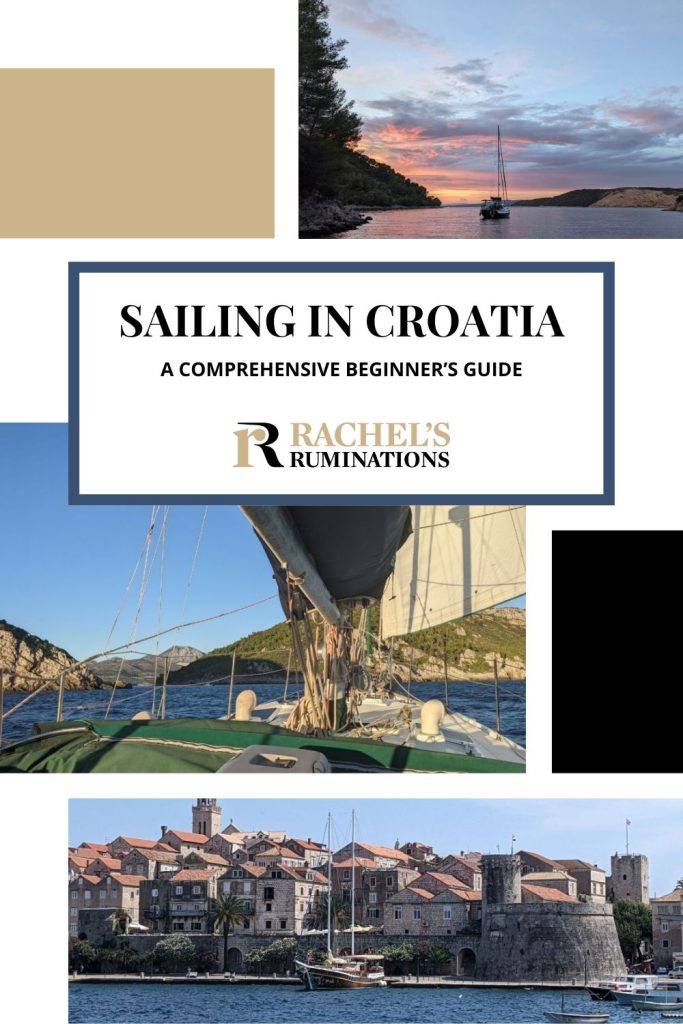
Having lived aboard our sailboat in Europe for six years now, we’ve been lucky enough to visit some amazing countries, but Croatia really does have something special about it. We sailed there for six months and never once got bored of the cities, towns and natural beauty.
But is sailing in Croatia any good for beginners?
As a beginner sailor, you want a few things: calm weather with light winds and settled seas, protected anchorages and marinas, and reliable charter companies. Croatia has these things in spades, which is probably why it’s one of the main sailing hubs in Europe.
If you’re setting sail in Croatian waters this summer or planning to in the future, then you’re going to want to read this guide detailing the best sailing routes, the perfect time to visit, and the ins and outs of sailing here as a beginner.
When is the best time to go sailing in Croatia?
As a beginner sailor, the best time to go sailing in Croatia is the summer. From around June until September the weather in Croatia is relatively settled and warm. You might experience a thunderstorm or two, but it’s a lot less common than during the shoulder months or the winter.
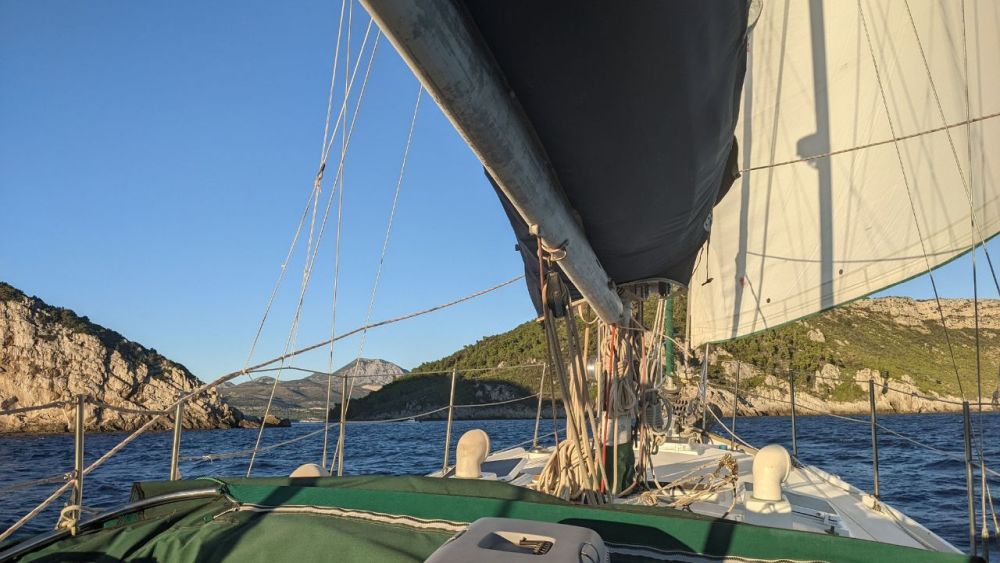
The wind tends to be calmer and more predictable, so you’re more likely to have smooth passages and you won’t have to worry so much about finding sheltered anchorages.
With the summer sun, you’ll find the sea is a lot warmer so you can enjoy various different watersports and you won’t have the hassle of wearing a million layers while you’re out sailing.
The biggest downside to sailing over the summer months is the crowds. You’re going to be sharing the best anchorages with a lot of people! Sometimes this works out for the best though, as you’ll probably meet some amazing people who will make your sailing holiday even more fun.
What are the best sailing routes in Croatia?
Croatia is a sailing paradise. There’s an area for everyone, from beginner to experienced, each with its own unique challenges and hidden surprises.
Probably the best area to sail as a beginner is the area from Dubrovnik to Split, which includes all the little islands in between. Both Dubrovnik and Split are great places to start your sailing adventure as they’re well set up with reputable charter companies, sheltered marinas, and less exposed seas.
You can hop between islands around here in less than a day so exploring wide and far is possible even with only a week’s holiday.
We’ve put together a suggested beginner sailor itinerary below. It starts in Dubrovnik and could take a week or two depending on how long you want to stop on each island.
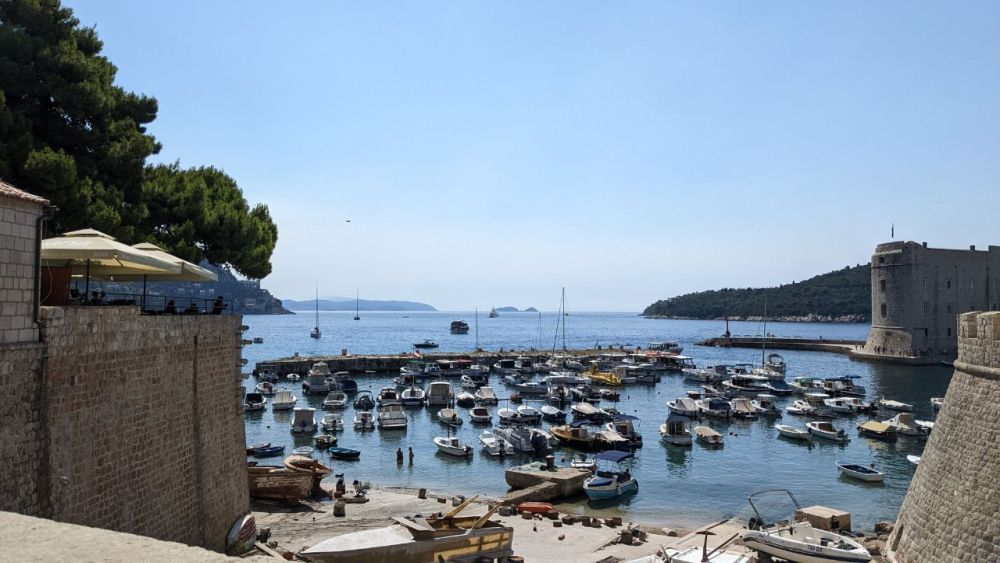
Dubrovnik to Split and back
If you’re chartering a sailboat from beautiful Dubrovnik, then you’re going to want to make sure you spend a few days on land here first to take in the old town. It really is impressive, and it’s clear why some call it the ‘Jewel of the Adriatic’.
When you’re done exploring all that Dubrovnik has to offer, hop aboard and head for your first island. Mljet Island is famous for its national park status and anchoring here is a bit of a privilege.
If you decide to anchor in the north of the island where Mljet National Park is, you will need to pay a small anchoring fee. This will be collected from you on arrival. Then you’ll also pay an admission fee to the national park. Once you’ve got the admin out of the way you are free to explore the park with its many stunning hiking trails.
If you’re not feeling so energetic (the summers here can be brutally hot), head to the town of Polače instead, on the western side of the island. This is home to a number of ancient ruins, along with some great bars and restaurants.
After a few days of exploring Mljet, set sail for Korčula. This was one of our favourite islands and shouldn’t be missed! There are so many beautiful bays on the island, so depending on which is most sheltered from the wind you will almost certainly find a beautiful little spot to moor up in.
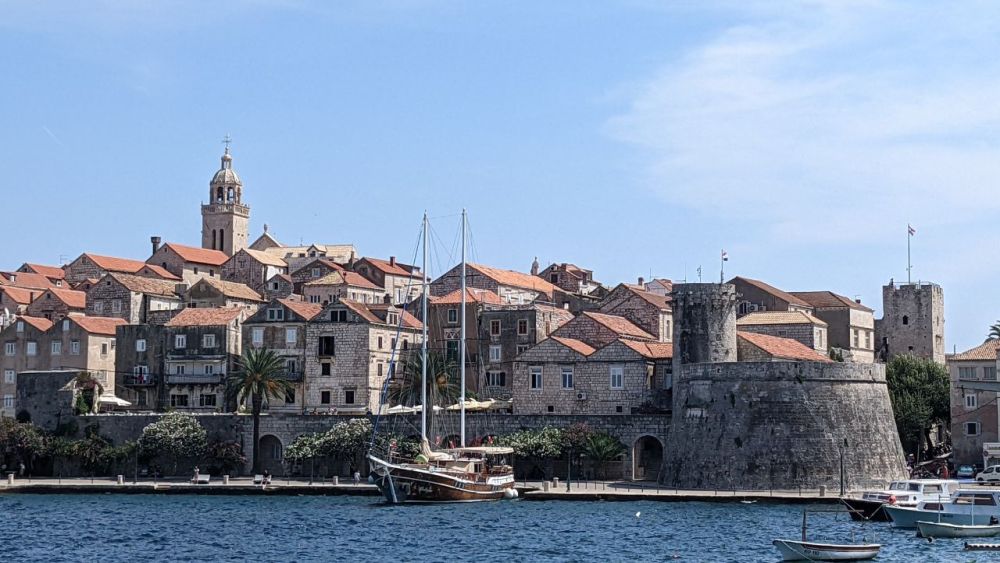
There are some great things to do on Korčula, so once you’ve enjoyed some serious beach time, head to the main town with its ancient castle and town within. Korčula is the reputed birthplace of Marco Polo and there is a museum you can visit that details his life.
For your final island, sail to Hvar, playground to the rich and famous. If you want a little luxury after several days at sea, then Hvar town is the place to go. Here you can dine out in style while you watch the super yachts coming and going, or walk up the city walls to admire the view. If you prefer a quieter spot, then Stari Grad is equally as beautiful but a little more understated. You could rent a bike and explore the UNESCO site called Stari Grad Plain.
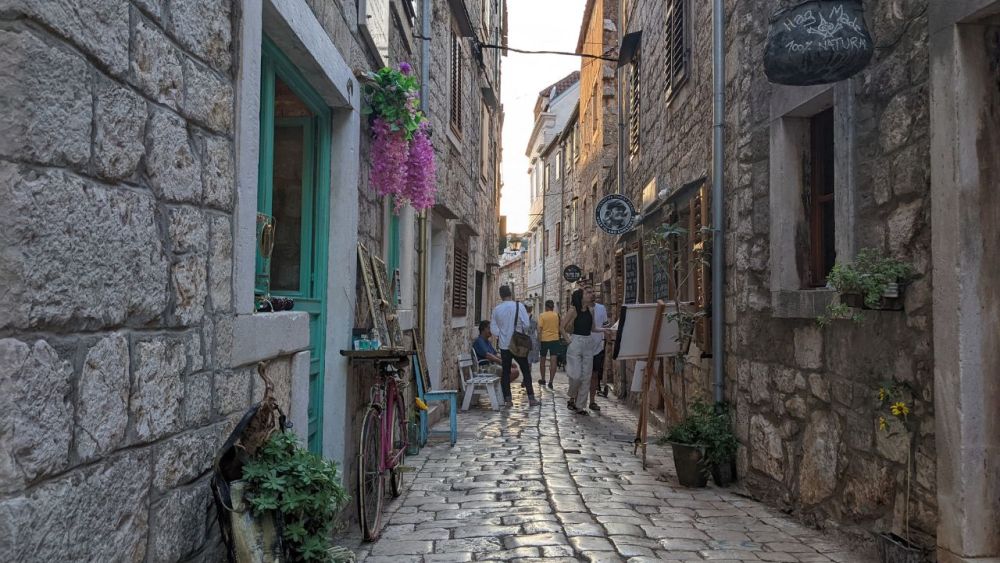
If you’re starting and ending your charter in Dubrovnik then hop back the same way but try to stop in different anchorages so you have the chance to explore further (or simply revisit some of your favourite stops!)
If you’re ending your charter in Split, then you have the option to stop off on the island of Brac on your way or head straight for Split. Brac doesn’t have quite so many sheltered anchorages so you will need to watch the wind carefully, but it is well worth exploring if you have the time.
Split is definitely worth a few days if you’re ending your trip there. It’s a fascinating amalgamation of a 3rd-century Roman palace around which the current city has grown.
Day sailing trips
Not sure if sailing is for you? If you’ve never been sailing before then you might want to consider a holiday on land with a day sailing trip to test the waters. Hvar has some excellent day sailing trips. This one to the Pakleni islands will give you a taste of sailboat life and the chance to see the beautiful little chain of islands just off Hvar.
What to pack for a sailing trip to Croatia
Packing for a sailing trip is always a little more complicated than packing for a normal holiday. You’ll need to travel light as there isn’t much room on a sailboat, but you’ll also want to make sure you have everything you need as there aren’t many shops in the middle of the sea!
Here’s a comprehensive list of what we would pack for a week or two sailing the Dalmatian Coast:
Clothing
- Lightweight layers: The weather can vary, so pack a mix of lightweight clothing that you can layer. Bring T-shirts, tank tops, shorts, and lightweight pants.
- Swimwear: Bring several swimsuits as you’ll be spending plenty of time in the water.
- Sun protection: Include a wide-brimmed hat, sunglasses with UV protection, and a lightweight, long-sleeved shirt for sun protection.
- Warm layers: Evenings can be cool, especially on the water. Pack a fleece jacket or a lightweight sweater.
- A waterproof jacket: A good quality, lightweight waterproof jacket is essential for unexpected rain or spray.
- Deck shoes: Non-slip, non-marking deck shoes are important for safety on the boat.
- Sandals, flip-flops or other light shoes: For comfort when onshore.
- Casual evening wear: For dinners and exploring towns. Croatia has a relaxed dress code, so casual clothing is generally acceptable.
- Underwear and socks: Enough for the duration of your trip, plus a few extra pairs.
- Sleepwear: Comfortable sleepwear for warm nights.
Sailing gear
- A sailing jacket: A quality jacket designed for sailing will be water and windproof, and will have all the necessary reflective strips for safety. One sailing jacket can do double-duty as the waterproof jacket listed above as well; no need to bring two.
- A lifejacket for sailing: Make sure you contact the charter company beforehand to ensure they have personal safety equipment onboard. We always bring our own just in case.
- Water shoes: Useful for rocky beaches and getting in and out of the water.
- Sailing gloves: Useful optional extra for protecting your hands from lines and anchor chain.
- Dry bags: Keep your valuables and electronics safe from water.
- Snorkeling gear: Mask, snorkel, and fins for exploring the underwater world.
Toiletries and personal items
- Sunscreen: High SPF, water-resistant sunscreen is a must. If at all possible, make it the reef-safe kind.
- Lip balm: With SPF to protect your lips from the sun.
- Insect repellent: To keep mosquitoes at bay.
- Personal medications: Any prescription medications you need, plus seasickness tablets if you’re prone to motion sickness.
- Basic first aid kit: Include band-aids, antiseptic wipes, pain relievers, and any other personal first aid items you might need.
- Travel-size toiletries: Shampoo, conditioner, body wash, and toothpaste.
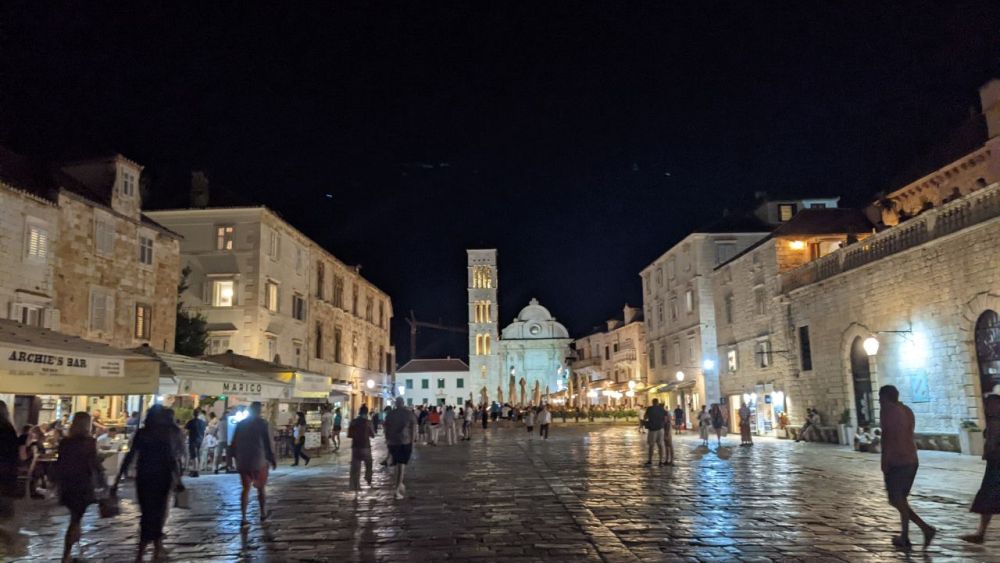
Electronics
- A camera or smartphone: To capture the stunning scenery.
- Chargers and power banks: For all your electronic devices.
- A waterproof phone case: To protect your phone from water damage.
- A portable speaker: To enjoy music on deck.
Miscellaneous
- Travel documents: Passport, sailing licenses, insurance documents, and any other necessary travel paperwork.
- Money: Croatia recently joined the Eurozone, so the euro is the legal currency. Bring some cash (Use an ATM at the airport on arrival or at any local bank), a debit card and a credit card. Make sure your debit and credit cards are set to allow their use in foreign countries.
- A guidebook and maps: To help you navigate and explore.
- A reusable water bottle: Stay hydrated while reducing plastic waste.
- A book or e-reader: For relaxing on deck.
- A notebook and pen: To jot down memories or notes.
- A towel: Quick-drying, microfiber towels are best for sailing trips.
- A reusable shopping bag: Handy for groceries and carrying items to and from the boat.
Accommodations before and after your sailing trip
Don’t forget to book your pre- and post-sail accommodations!
Do you need a license to sail in Croatia?
Yes, you do need a license to sail in Croatia. The Croatian authorities require that at least one person on board holds a valid skipper’s license, which includes both a certificate of competence and a VHF radio license.
Here’s a more detailed look at what you need to sail legally and safely in Croatian waters:
1. A skipper’s license
Croatia recognises various international sailing licenses. If you’re an EU citizen, licenses like the ICC (International Certificate of Competence) are widely accepted. Non-EU citizens should check if their home country’s sailing license is recognised by Croatian authorities.
Popular licenses that are generally accepted include:
- RYA Day Skipper
- RYA Coastal Skipper
- ASA 104 (Bareboat Cruising)
- US Sailing Bareboat Cruising Certificate
Local Licenses: If you don’t already hold an accepted license, you can obtain a Croatian license. These are issued by the Croatian Ministry of Maritime Affairs after you pass a competency test.
2. A VHF radio license
In addition to a skipper’s license, a VHF (Very High Frequency) radio operator’s license is mandatory. This is crucial for communication with marinas, harbours, and emergency services. The VHF radio license is sometimes included in comprehensive sailing certifications but can also be obtained separately.
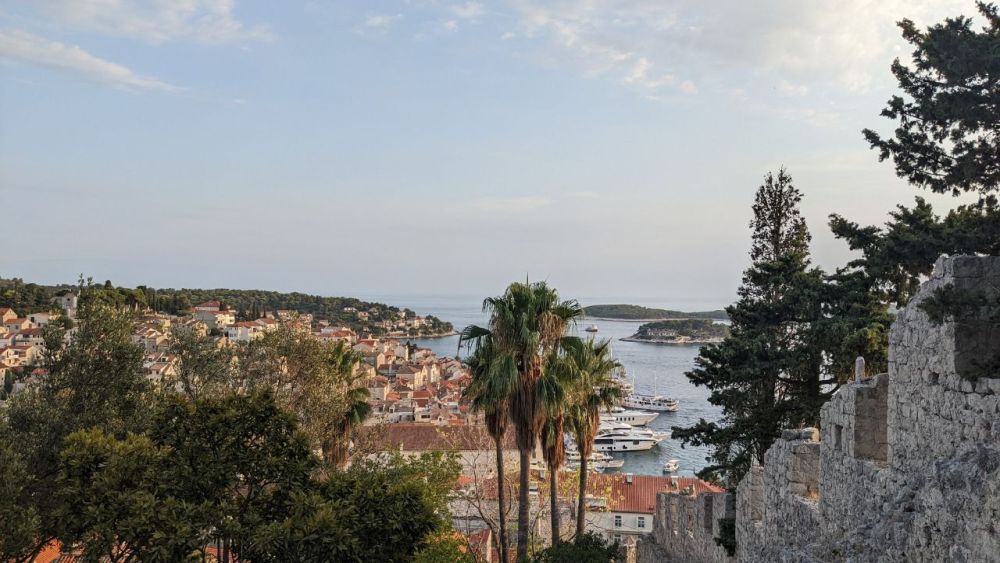
Chartering a yacht in Croatia
If you’re planning to charter a yacht in Croatia, the charter company will require you to present your valid skipper’s license and VHF radio license before handing over the vessel.
If you don’t hold a skipper’s license, don’t panic. You can book a charter that offers skipper services. A qualified skipper will join you on your adventure and you won’t be required to lift a finger if you don’t wish to.
This is a great option if you want to get experience before taking the qualification yourself, or if you want to truly relax on holiday. Taking a skipper with you will also ensure you get all the top tips on destinations, weather patterns and anchorages.
Day charters
If you’ve never been sailing before then you might want to consider taking a day trip rather than spending weeks at sea. You can suss out whether you get seasick or enjoy the constant motion and small space living. For some, it’s a dream lifestyle, but for others what sounds romantic can turn out to be a bit of a nightmare.
Luckily there are some great sailing day trips available. I mentioned one above that leaves from Hvar. Here’s another day trip that leaves from Dubrovnik.
If you want a taster to see how you like overnight sailing, here’s a 3-night trip from Dubrovnik.
Top tips for chartering in Croatia
- Ensure your license is up-to-date and recognised by Croatian authorities well before your trip.
- Carry documentation: Always have your original license documents with you, as you may need to present them to port authorities or during spot checks.
- Read up on local sailing laws. In Croatia, for example, you must head straight out to sea once you have checked out of the country. You must also check in at the first customs port you pass.
- Refresh your skills: If it’s been a while since you last sailed, consider taking a refresher course or practising your skills to ensure a smooth and enjoyable sailing experience.
- Speak to the charter company about safety equipment onboard to ensure you’ll be provided with enough life vests for the whole party. You might also want to ask about fire safety provisions and medical kits on board.
Anchoring In Croatia
Croatia is a little different to many other European countries when it comes to anchoring, so there are a few things to be aware of before you go dropping the hook.
Croatia has some strict rules in place when it comes to anchoring in certain parts of the country. Although this is a little irritating sometimes, it’s actually a really good thing, as it’s protecting the local wildlife and ensuring there will be beautiful sailing here for years to come.
Being aware of the places you’re allowed to anchor will save you hefty fines and a whole lot of stress! You can check out Navily or No Foreign Land, two of the best sailing apps, to see where you’re allowed to anchor.
On some of the islands in Croatia the water is too deep close to the shore, so you will need to take a mooring ball. The mooring balls tend to be really well maintained but we would always advise diving them to double check so you get a good night’s sleep! Usually, each mooring ball is attached to a local restaurant so you just need to make sure you eat there in the evening. Such a hardship!
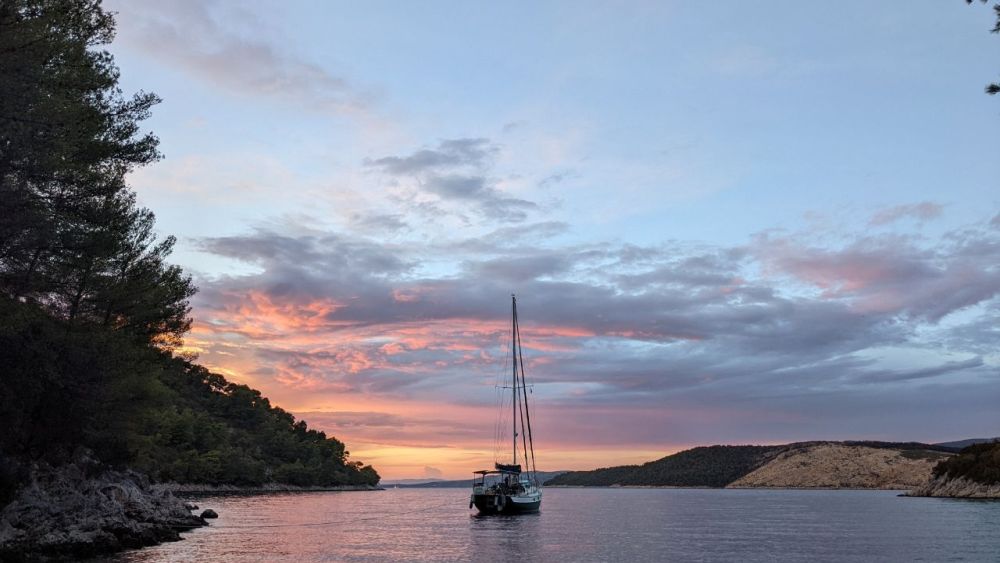
Is Croatia good for sailing?
Having sailed throughout Europe, we found Croatia to be one of the best destinations for a sailing holiday. Although the laws around anchoring and checking in and out were a little stricter than in other countries there were so many aspects that make Croatia a dream sailing destination.
Here are just some of the reasons we loved our time here and would definitely sail back again in the future:
Stunning coastline and islands
Croatia boasts over 1,000 islands and a coastline that stretches for more than 1,200 miles (over 1,900 kilometers). This vast expanse of navigable waters offers a huge range of sailing experiences for all abilities. The islands of Hvar and Korčula are among our favourite all-time islands across the whole of Europe.
Favourable weather and sailing conditions
The Adriatic Sea enjoys a Mediterranean climate, providing ideal sailing conditions from late spring to early autumn. Summers are warm and sunny, with consistent winds like the Maestral blowing in the afternoon, perfect for sailing. Even during the shoulder seasons, the weather is generally mild, though we wouldn’t recommend risking it as a beginner.
Rich cultural heritage
Croatia’s coastline is dotted with historic towns and cities that offer a glimpse into the region’s rich history. We’d come from Greece which is famous for its history so we were really surprised by the towns here. From the Roman ruins in Split to the medieval walls of Dubrovnik, there’s no shortage of cultural and historical sites to explore.
Modern marinas and facilities
Croatia has invested significantly in its marinas and ports, which is perhaps one of the reasons sailing has become so big here. Marinas are usually incredibly well-maintained, clean, safe and well-equipped. Just expect to pay for the privilege!
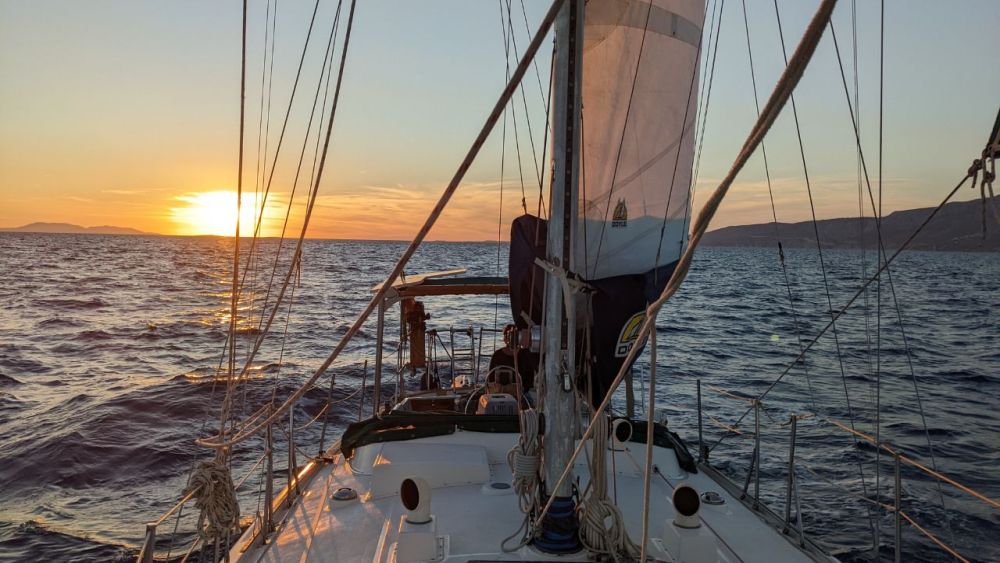
Accessibility and charter options
The country is easily accessible from many European cities, with several international airports located near major sailing hubs like Split, Dubrovnik, and Zadar. Additionally, Croatia has a wide range of charter companies offering various types of boats, from luxurious yachts to budget-friendly sailboats, usually with the option to employ a skipper.
Clear waters and marine life
The Adriatic Sea is known for its crystal-clear waters, which offer excellent visibility for diving and snorkelling. We had heard rave reviews about how clear the water here was, but it’s one of the things that didn’t compete with Greece.
Saying that, the underwater world is rich with marine life, including fish, octopuses, and colourful corals. It’s the first place in Europe where we spotted octopus.
Safety and community
Croatia is known for being a safe and welcoming destination for sailors. The local sailing community is friendly and supportive, and you’ll find plenty of fellow sailors to share tips and stories with along the way.
The Croatian Coast Guard and maritime services are well-organized, providing an added layer of security and assistance if needed. Just make sure you stay on the right side of them!
Conclusion: Sailing in Croatia
Sailing in Croatia was a dream come true for us. With its stunning coastline, unique islands, favourable weather conditions, and rich cultural heritage, Croatia stands out as one of the top sailing destinations in the world.
And one of the best things about it is how perfect it is for beginners.
You can have the sailing adventure you always dreamed of while actually enjoying yourself, rather than worrying about finding safe marinas and navigating tricky ports. Your days will be filled with light sailing and dolphin watching, lots of swimming and paddleboarding in beautiful waters, and time exploring historical towns and dining out on delicious cuisine. (The pizzas in Croatia are fantastic!)
If you’re setting sail for the first time, make sure it’s to Croatia’s stunning coastline.
Have you enjoyed sailing along Croatia’s coast? Are you planning a trip like this? Tell us about it below!
My travel recommendations
Planning travel
- Skyscanner is where I always start my flight searches.
- Booking.com is the company I use most for finding accommodations. If you prefer, Expedia offers more or less the same.
- Discover Cars offers an easy way to compare prices from all of the major car-rental companies in one place.
- Use Viator or GetYourGuide to find walking tours, day tours, airport pickups, city cards, tickets and whatever else you need at your destination.
- Bookmundi is great when you’re looking for a longer tour of a few days to a few weeks, private or with a group, pretty much anywhere in the world. Lots of different tour companies list their tours here, so you can comparison shop.
- GetTransfer is the place to book your airport-to-hotel transfers (and vice-versa). It’s so reassuring to have this all set up and paid for ahead of time, rather than having to make decisions after a long, tiring flight!
- Buy a GoCity Pass when you’re planning to do a lot of sightseeing on a city trip. It can save you a lot on admissions to museums and other attractions in big cities like New York and Amsterdam.
- Ferryhopper is a convenient way to book ferries ahead of time. They cover ferry bookings in 33 different countries at last count.
Other travel-related items
- It’s really awkward to have to rely on WIFI when you travel overseas. I’ve tried several e-sim cards, and GigSky’s e-sim was the one that was easiest to activate and use. You buy it through their app and activate it when you need it. Use the code RACHEL10 to get a 10% discount!
- Another option I just recently tried for the first time is a portable wifi modem by WifiCandy. It supports up to 8 devices and you just carry it along in your pocket or bag! If you’re traveling with a family or group, it might end up cheaper to use than an e-sim. Use the code RACHELSRUMINATIONS for a 10% discount.
- I’m a fan of SCOTTeVEST’s jackets and vests because when I wear one, I don’t have to carry a handbag. I feel like all my stuff is safer when I travel because it’s in inside pockets close to my body.
- I use ExpressVPN on my phone and laptop when I travel. It keeps me safe from hackers when I use public or hotel wifi.





